August 24 - 30, 2014: Issue 177
Ken Davidson
At the mention of the name of Ken Davidson, a Life Member of Avalon Beach SLSC, faces light up and smile. Esteemed in our community, this gentleman has some wonderful insights into the early days of Avalon Beach SLSC and advances in his field of Chemical Engineering during his career.
When and where were you born?
North Shore – Roseville, November 1927.
Where did you grow up?
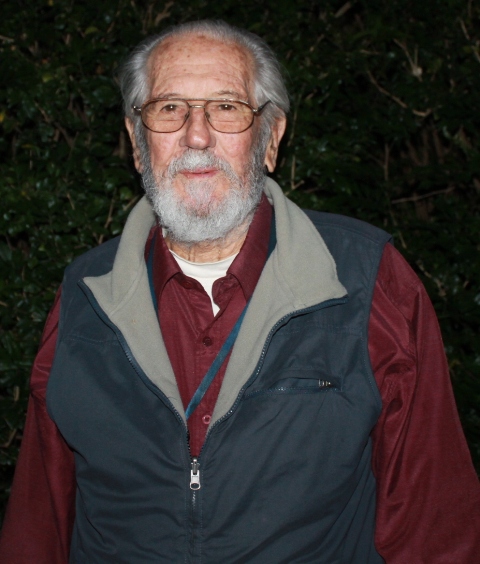 Mostly around Roseville. There’s a street that runs on to the tail end of the golf course there and we used to play cricket in the street, ride bikes, fly model aeroplanes off the golf greens. We’d explore down the creek and follow it along to Roseville Chase, and to the swimming pool and boatshed they used to have there.
Mostly around Roseville. There’s a street that runs on to the tail end of the golf course there and we used to play cricket in the street, ride bikes, fly model aeroplanes off the golf greens. We’d explore down the creek and follow it along to Roseville Chase, and to the swimming pool and boatshed they used to have there.
When we first built there only about three houses had been put up on the opposite side of the road and the valley was almost devoid of houses until you got to Lindfield.
Quite a number of houses had gone up on our side of the road, which was the city side, but not that many on the other side, just lots of bush – a great place to grow up.
Over the next fifteen years it grew and grew.
Where did you go to school?
I started at Roseville Public school, which was just up from us in Archibald road. Then a couple of years at Artarmon before going on to high school and the Leaving Certificate
How did you become a Chemical Engineer?
An aunt of mine was fairly ambitious for me. She insisted I try to get to Sydney University and Engineering was the obvious course.
In the meantime as a result of holiday and weekend visits we’d got to know a Greek migrant, Theo Aroney, who like all Greeks ran a small shop located where Woollies is now. It was a mixed business – groceries, vegetables and a small cafeteria. He asked my brother and me if we’d like to work weekends and that provided a certain amount of pocket money for school.
We had moved down to Avalon after my father (Thomas Keith) came back from the Army. This would have been quite late in 1945, when joy of joys, I was still only 17. I had joined the Air Training Corps at the time. This included visits to a camp in Avalon out towards Clareville which was another favourite week end spot pre-war.
It was decided to sell the place at Roseville. This was a problem as you couldn’t afford to buy a house outright – the prices were basically frozen; too low to sell, then buy so if you wanted to have a house in a particular area you had to find someone who was wanting to get out of the district and more or less do a house swap with a cash adjustment, so one way or another you got a reasonable price for your house, whereas if you sold it as it stood it was very hard to get value for your money.
I joined Avalon Beach Surf Club in 1946.and earned my Bronze Medallion in April 1947 . Brother, Neil, who was four and a half years younger than me, born in 1932, with the Harbour Bridge came on as a cadet that summer. In due course, my father was President of the Surf Club for a period and President of the Bowling Club at one stage too. His father had played bowls. The family had come from South Australia where his home had been directly opposite the bowling green.
What was the Surf Clubhouse like then?
There was just the central room and public change rooms each side for girls and boys. side. It was pretty basic. We started by putting up a boat shed on the north end, which was done through people in the district and within the club, everyone was always keen to help out. One of our bricklayer was a Dutchman who got ribbed because he was wearing a pair of wooden clogs. When asked ‘what the hell are you wearing them for?’ he would stand up and ‘accidentally’ drop a brick, which bounced straight off them of course…so there were no more silly questions after that.
What was your favourite…the ski, the boats…what did you specialise in when you joined?
At the time I remember Ted Hock, he ran the Golf Club, he had two boys, one of whom did medicine, and young Ted who wandered, an early “surfy”. We used to get down the beach and we knowing how to manipulate the padlock on the boatshed door; we’d borrow a surfboard, get into the surf. I liked the boards.
The first surfboat I went out in was named the ‘Miss Queenscliff’. This came from the Queenscliff club and I’m not sure wether we bought it or they donated it or were just delighted to get rid of it. It had a mind of its own, when on a wave you rode the boat not the wave. Taking it up the beach would require the entire membership and about three recovery breaks.
What was it like on the beach then – there seems to be a lot of sharks coming in to Avalon during the late 40’s and early 1950’s?
There were reports of large sharks around Pittwater and Broken Bay but we had seen none close to the beaches.
Well we started getting bigger crowds on the beach every Summer but it was still quiet during the week. This suited the locals. On one occasion Teddy Hock and I had been out having a good session on a fairly typical Avalon surf, not necessarily conveniently always rideable. Every so often we’d be up but fall off and have to swim to recover the board - I spent a lot of time off the board, as much off the board as on. Worn out, we came in, had a good shower (cold), then moved out in front of the clubhouse to warm up. There, in that gap between the reef at the south end and the rock pool were two large fins at least about a foot (300 mm) high.
We didn’t have the nous to go up to the top of the hill and have a good look. After all sunfish were not unusual off the beach and these are almost all fin. Still we immediately thought “sharks”. I’m not sure how long they’d been around but was happy it hadn’t coincided with my falling off the board. They were the only ones I saw apart from the one that was caught off the surfboat.
The one you dived on?
I didn’t dive on it. That was reported incorrectly.
Avalon Lifesaver Bitten By Shark
A 23-year-old lifesaver dived off his surf-board and fought a 6ftcarpet shark in five feet of water to stop it from approaching a group of children in the surf at Avalon yesterday. During the struggle the shark bit his stomach. A doctor inserted three stitches in the gash caused by the bite. The lifesaver, Ken Davidson, chemical engineer, of Dress Circle Road, Avalon, was patrolling the beach when other surf-club members saw the shark and gave the alarm. Davidson raced into the water with his board and paddled out to the shark.
GRABBED TAIL
"It was swimming towards a group of small children playing in the surf," Davidson said. "The only way I could stop it from getting close to them was to grab hold of its tail. "I didn't realise it was quite so big when I dived off the board."
Davidson's brother, Neil, 18, ran into the water with a spear gun to help him. Neil Davidson fired a steel arrow at the shark, but the arrow bent and glanced off when it struck the shark's head. The Avalon surf-club captain, Harry Ragan, and six other club members also raced into the water to help the brothers. One of them, Alan Slevin.21, took a shark spear from the clubhouse.
PINNED BY SPEAR
Ragan said they circled around the shark, jumping and splashing neck-deep in the water, to force it in toward the beach. They threw the shark spear to Ken Davidson, who had climbed back on to the board, and he tried to spear the shark.
He missed several times and tossed the spear to Neil Davidson, who dived under the water and stabbed the shark twice. It broke away and swam at Max McCredie, another life saver. McCredie leapt up and the shark darted beneath him. Neil Davidson then drove the spear through the shark, pinning it to the sand. The men dragged it ashore and killed it on the beach.
TEETH IN BELT
Ken Davidson said: "I have tackled three-footers before but never a 6ft shark. I won't be too anxious to do it again. "When the shark swung round to attack me its lower teeth caught on my webbing belt-luckily. "If they had not it could have given me a far more vicious bite. "I let go pretty fast when it bit." _ Avalon Lifesaver Bitten By Shark. (1951, March 27). The Sydney Morning Herald (NSW : 1842 - 1954), p. 1. Retrieved from http://nla.gov.au/nla.news-article18205758
What happened there?
Well, it was a regular patrol, half a dozen starters, a reel and a board or two. south end area, small surf, shallow bank draining into a channel about waist deep. We heard, then saw a surfer trying to set a new record for waterwalking yelling something about a ten foot hammerhead shark. All we could see looked like a piece of seaweed drifting in across the bank and washing into the channel. I grabbed my board to check and escort it if possible down the gutter to the run out rip. On closer view I saw that the shark was only a wobbegong about 5 -6 feet long. After a bit of thought I slid off the board and grabbed it by the tail. In previous weeks we’d been fishing quite a bit around the rocks, and had caught quite a number of Port Jackson sharks. These were fairly solid. If you held them close to the tail they would bend their bodies but only over a small arc. Not so that bloody Wobbegong – it could flip up 180 degrees leaving a foot or two complete with angry snapping head aimed in my direction, I was hit by a buck tooth on the way down– we parted by mutual consent. Then my brother took over with his spear gun.
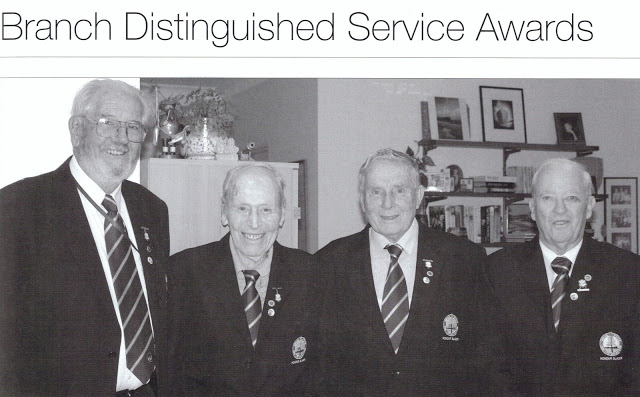
Ken with Doug Crane, Max Watt and Don Imison
Which was the shark you boys displayed and earned funds for the surf Club?
That was with Maxie (Watt) and the boat crews. They’d set a rig up with two petrol drums, four gallon drums – the first was connected to an anchor and line. A second line about 20 feet/six metres ran to the second drum which supported the dropper line with a reasonably big hook and the bait. Pulling those drums underwater took quite a bit of doing.
My story may clash a bit with other’s versions, but that’s how I saw it. The boatcrew rowed out to check the buoys, and I paddled out with them on the surfboard. Max was on stroke and he stopped the boat and put his hand over the side – you could see something was around, something was hooked on it. They pulled in the anchor, pulled in the drum and started pulling in the line. Up came a head you couldn’t fit in a banana case! Maxie threw it back over the side and I guarantee he’d done two strokes before his bum hit the seat!
That was the Tiger Shark we caught, all twelve feet of it – it was twenty two inches across the hinges of its jaws – it took all of the club to get it up the beach and several others who were on the beach. We beached it up the north end.
We got twelve quid for it – a quid a foot in donations. We wanted to get rid of the body and one of the boys, who died up in New Guinea later on, decided to retrieve the jaws – he raced home and brought down a big machete that never looked like cutting the skin of this tough shark – we got a hacksaw and that got the jaws out – there was a six deep circle around us – they rolled it over to begin cutting up the meat and then someone cut open its gizzards – you could tell where the breeze was coming from after that moment; downwind cleared pretty quickly.
We found a number of cattle bones in there, the skeleton of a few dogs. That particular year there had been a number of floods in the Hawkesbury and quite a few cattle lost, and clearly some had been eaten by this shark.
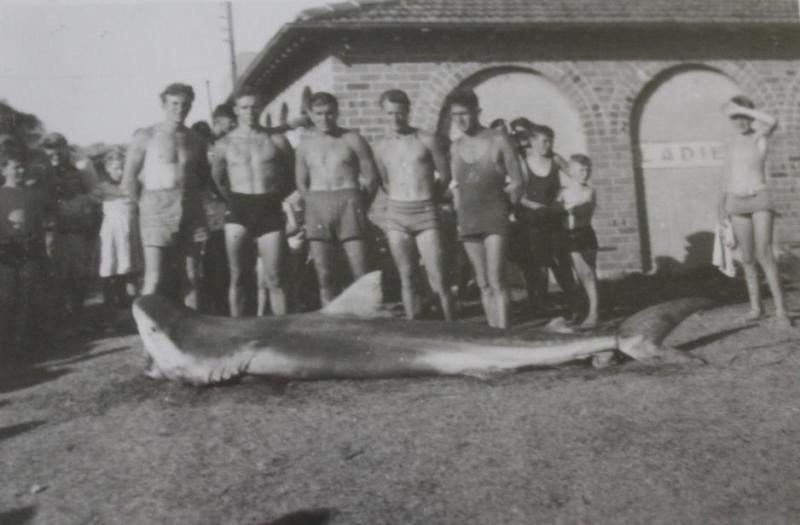
Left to right: Jim Campbell, Max Watt, Brian Sheehan, Geoff Gearside and Max McCredie.
So you have been a member at Avalon Beach SLSC for almost 70 years?
Yes, coming up to 70 years.
What are some of the changes you’ve seen during that time?
Well, this is my fourth clubhouse I suppose; with the new one being completed. There was the basic dressing sheds, that were then stretched a bit, then replaced and then knocked down and built on top of it.
Another change would be Nippers, we had no Nippers in the old days. You joined the club as a junior at age 16 then.
So the beach wasn’t your only aquatic activity?
After the 1960’s most of my water activities were in sailing with the Alfred’s – Royal Prince Alfred Yacht Club. Occasionally we’d sail from Pittwater to the Harbour.
At this stage I was married and living on one side of my parent’s block and someone built on the other side who had a boat – I have a sneaking suspicion that his wife hooked me into sailing the boat as a safety precaution. The yacht was called Maria, it was a Diamond, she used to fly.
I’d graduated to Reserves at the Surf Club during this period. I’m not sure I was a hell of a lot of help then.
I eventually bought a Diamond myself around 1980 named Careel, it belonged to the chap who was running North Sails at the time. After that I did a fair bit of sailing in OP’s; ‘other people’s; I had a great time.
I remember Wally Wardle – he was a teacher down at Pittwater and selected my second son to skipper in Kalori at one stage too. He was only in Year 9 then, but was tall like me; Wally said ‘Hmm, you’ll do’, and gave him a go.
How did you meet your wife?
Hermie lived in Avalon - her maiden name was Broeksema, she had Dutch heritage – I met her around 1952, used to see her on the bus and on the beach. I was working in Botany by this stage – that was bus-tram-bus. She was working in Farmer’s in town as a dietitian.
DAVIDSON - BROEKSEMA. – The Engagement is announced of Hermien, only daughter of Mr. and Mrs. J. Broeksema of Avalon to Kenneth, elder son of Mr. and Mrs. T. K. Davidson of Avalon Beach. Family Notices. (1954, November 20). The Sydney Morning Herald (NSW : 1842 - 1954), p. 40. Retrieved from http://nla.gov.au/nla.news-article18460939
How many children do you have?
Four. Two boys and two girls. The first was born in 1957.
What does being a Chemical Engineer involve?
The course I did is better described as ‘Process Engineering’; we had three plants around the country where they were drying starch, alias cornflour, we were drying gluten as gluten used to be quite a valuable product – there was a reasonable amount of gluten in bread.
I did some work in a number of fertiliser plants. We also put in some equipment to recover the operating fluids in a polythene plant. The royal polythene was discharged into a bath where it would dissolve some of the cotton and end up as quite a nice material for clothing.
I started off with a crowd called Davis Gelatine. I then moved to Kestner Evaporator and Engineering Co., Ltd.; which supplied the equipment for drying the starch, evaporators for use in milk concentrates; these concentrated whatever you like. This was an English parallel company to a company in France.
They got me up to New Guinea on one occasion to try and commission a plant which had been in Indonesia since before the war, and survived the war, which they wanted to get going again.
I started off in Port Moresby And then went to a place west and on the south coast to a place they call the Kakori river, in the middle of the biggest swamp in the place as they wanted to recover this bark from the mangrove tress growing there. They’d strip the bark off these plants and cook it up. The tea that came off was then put through a series of evaporators to come out as a concentrated tan extract. This had been used very heavily before the war in fishing nets and products alike these as a preservative. Then along came nylon.
What was the most interesting work you did in this field?
Low alcohol beer. This stuff used to come out about 0.09% alcohol instead of 0.5. The first plant that went in for Swan Breweries, which was Swan Special Light. Later on we supplied one for CUB in Broadway. Later anther was installed in Melbourne and another one we put in in the UK which belonged to Carlton – the Courage Brewery.
I went there to help them with the estimate; we’d worked this up out here as an Australian development and were taking it home to mum so to speak. I worked up the tender for them and was getting ready to go home when they given the order – it was the end of July and all the holidays were coming up – so I ended dong the Engineering for them there instead of coming home.
Did you ever go in any of the Carnivals?
Oh sure – they were great fun. These were the restricted Carnivals; from Collaroy right up to the north clubs. Everyone would go in everything; the March Past, the Surf Races on Boards, Ski.
We used to clean up on the timber events – Maxie Watt would get the ski race and I’d get the board race, and my brother came pretty close to my mark. We did reasonable well in the boat races as well.
SURFING
AVALON -Senior belt race D. Crane 1 B Head 2., M McCready 3 Surf ski race R Wood 1 M Watt 2 N Davidson 1 Surf board race K Davidson 1 I Gorrie 2 SPORTING IN DETAIL. (1951, March 19). The Sydney Morning Herald (NSW : 1842 - 1954), p. 7. Retrieved fromhttp://nla.gov.au/nla.news-article18204590
SURFING
AVALON Club championships Senior surf 2nd round M Unicomb 1 A Hyde 2 M Irving 3 Senior belt J Day 1 A Hyde 2 M Unicomb 3 Junior belt B Sproule 1 D Mitchell 2 J Watt 3 Ski | M Watt 1 N Davidson 2 R Brown 3 Board K Davidson 1 M Watt 2 J Day 3 Senior beach sprint J Campbell 1 N Davidson 2 A Buxton 3 junior beach sprint B Sproule J Watt dead heat 1 D Costain 3. SPORT DETAILS. (1954, December 20). The Sydney Morning Herald (NSW : 1842 - 1954), p. 11. Retrieved from http://nla.gov.au/nla.news-article18463039
PALM BEACH RESTRICTED CARNIVAL
Senior R and R: Newport 8.58 points 1 Avalon 9. 77 2 Palm Beach14.6,3 Senior belt race H Bailey(Whale Beach) 1 R Stanford (Palm Beach), 2 M Unicombe (Avalon) Junior Belt: G Martin (Whale Beach), 1, J. Rowe (Palm Beach), 2, A Forrest (Newport), 3 Senior surf race. R Sharpe (Palm Beach), 1: I Curlewis (Palm Beach) 2, R Hoskin (Bilgola), 3 Senior teams' race: Palm Beach 1; Avalon and North Palm Beach (dead heat), 2 Junior surf race: J Davidson (Palm Beach), 1, G Martin(Palm Beach), 2, P. Richardson(Newport), 3 Junior teams' race: Palm Beach, 1: Newport, 2, Avalon,3. Senior boat race: Whale Beach,1, Bilgola, 2, Mona Vale, 3 Junior boat race Newport, 1, Warriewood, 2, Mona Vale, 3. Board race: O Ramsay(Whale Bench). 1, K Davidson (Avalon), 2, I Gorrie (Avalon), 3 Ski race: M Watt (Avalon), 1 N Davidson (Avalon), 2, R Watson (North Palm Beach). 3 Beach sprint: C Oai (Bilgola), 1, R Holmes (Warriewood), 2, I Gorrie (Avalon) 3.Beach relay North Palm Beach l, Warriewood. 2 Avalon 3 Cadet surf race: G Gardner (Warriewood).1, R Hervings (Avalon). 2 Total points. Palm Beach, 1, Avalon, 2, Whale Beach, 3. SPORT DETAILS. (1954, January 11). The Sydney Morning Herald (NSW : 1842 - 1954), p. 10. Retrieved from http://nla.gov.au/nla.news-article18404079
When on Patrol in those early days, what is the most memorable rescue you were part of?
I spotted a bloke caught in the south end rip with his two daughters. Nine out of ten rescues we did during that time were at the south end, caught in this rip. At any rate, he protested that he didn’t need rescuing so I asked him to have a look around him – they were out at sea!
Fortunately I’d taken the belt out with me, so coming back in was this bloke, his two daughters and me.
Those reels and lines are still available today but things have progressed – I remember it being a bit tedious when we used to have to run a line and belt up to the north end of the beach.
Avalon Beach quite often has a fairly shallow sandbank, with quite a bit of a gutter. When the surf is coming across that sandbank it can be difficult to swim on to it. I’ve lost count but can remember many occasions when someone has become a bit frantic and I’ve dived into the gutter and come up alongside them and said ‘right, give me your hand, put your feet down…the beach is that way.’
They could walk! …they were in the gutter but didn’t realise it was so shallow. They couldn’t get on to the bank but didn’t realise after the waves pass that the gutter is shallow – it happened to me too the first time I went out. So yes, sorting people out by letting them know they could stand up was a big one.
The other one I remember is how I always used to do my swimming and surfing out the back. We would use the rip to get out, and as I’d be going out I’d come across someone swimming like crazy to get back in. To them I’d say ‘stop; come with me’. We’d go out another 30 or 40 yards and they could swim across to get back in, to the sandbank, or the beach. In like Flynn they could go.
Rescue equipment has progressed – Avalon kicked off the rubber ducky - that was a big one for the club, a big shot in the arm for our members.
I also did 14 years as Treasurer for the club.
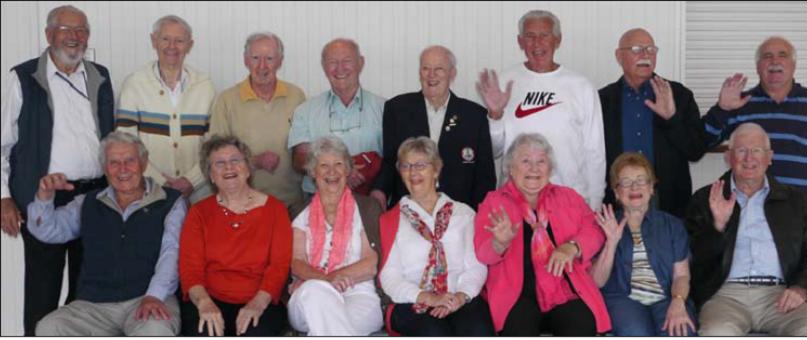
Top row: Ken Davidson, Ian Gorrie, Kevin Watt, Reg Wood, Don Imison, Ron Handley, Bob Head, Dennis Casali. Bottom row: Max Watt, Joan Watt, Marj Wood, Beryl Imison, Norma Watt, Mr and Mrs John Cameron
You and Neil spent a fair amount of time together when you were growing up?
Oh, yes, we were mates. Immediately after the war the only people in this area were pensioners or very young families with ankle-biters; none of whom were any use whatsoever in the surf club. Neil and I were it for a while there. Later on these young families were the source of our Nippers and much of our current expansion - i.e., Christine etc.
We lost quite a few through the war – they went overseas to serve and didn’t come back. Mr. Wickham’s son was lost, killed, among others.
Avalon was very quiet then. Through working at the shop I had use of two complimentary tickets, which came from Collaroy theatre as compensation for carrying their Notices in the window. I’d go there on a Saturday night for years. We used to go down by bus and come back by bus, these were the old double deckers.
In the Summer the crowd would increase, including the load on the buses. During this time we’d head south towards Dee Why and try and catch the bus early – there was one occasion when the lass who was ticket seller was jammed in the lower corridor, there must have been 15 people on the back platform, people all the way up the stairs, and I put my hand around the back and said ‘four to Avalon please’; four of us on the bumper bar. There was no further movement in the springs at this stage.
So almost 70 years in Avalon Surf Club, you’re a Life Member – what is the best thing for you about this surf club?
It’s like a home, what I’m used to. When I first joined it was having a great time with your mates. During the 1980’s I was part of that Sunday morning group when there would be as many as a dozen of us going out the back with hand-boards and we’d bodysurf for a couple of hours – that was great. Max and a number of others were part of that group.
Of course as time went on I found I wasn’t catching the waves as well as I used to – I found I was missing the wave. I decided to get my shoulders checked as they seemed to becoming restricted in how much I could lift my arm to make the swim stroke – I couldn’t tilt anymore. Even worse, I couldn't lift a middy!
By that stage I’d also done around 30 years of on and off sailing working a winch; I ended up having both shoulders done.
I haven’t caught a wave in the 21st century after my successful shoulder operations but did start going back to the beach to get a bit of training in and find my surfing instincts still come to the fore. I come around the corner of the clubhouse, my eyes go straight to the water ‘that’s too bloody big' or 'that's garbage – I’m not getting wet for that’, 'I should have gone down to the pool'.
What is your favourite place in Pittwater and why?
I like sailing around Pittwater – Careel Bay, Towler’s Bay, it's all great, but the family found a very nice little spot – this little beach north of Mackerel Beach. There was only one thing wrong with it - you’d be there with a beautiful sunny sky, a light nor’easter blowing, and the breeze would go up and over Barrenjoey and blow a cloud that would sit just there, hover, blocking out the sun and you’d be in permanent shadow. My wife and I spent our honeymoon on a Halverson up there – lovely.
What is your motto for life or a favourite phrase that you try to live by?
Anything can happen if you can hang about long enough!
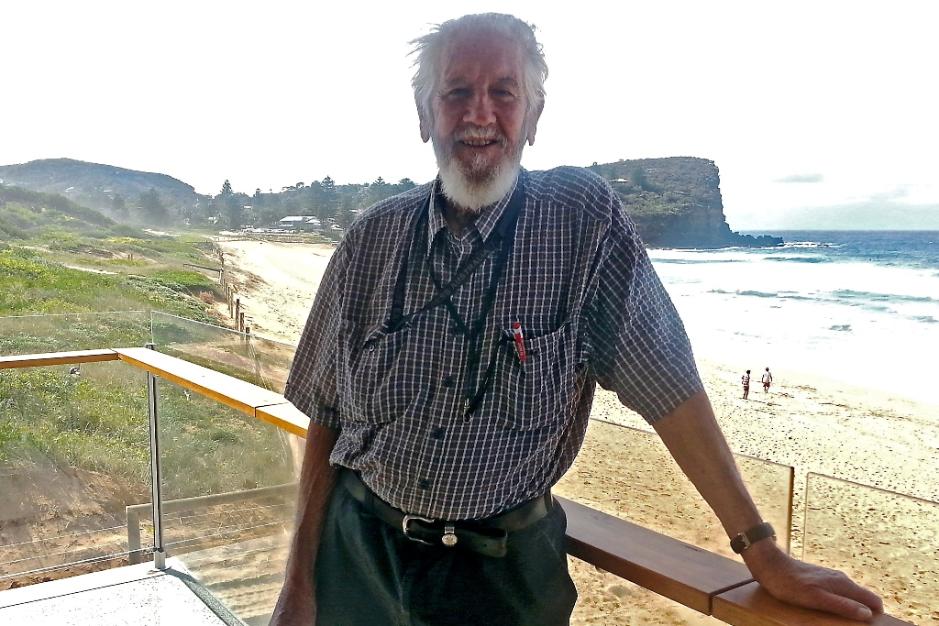
Ken at New Avalon Beach SLSC Clubhouse Picture by and courtesy of Philip English - taken at new Avalon Beach SLSC 23.8.2014
Copyright Ken Davidson, 2014.